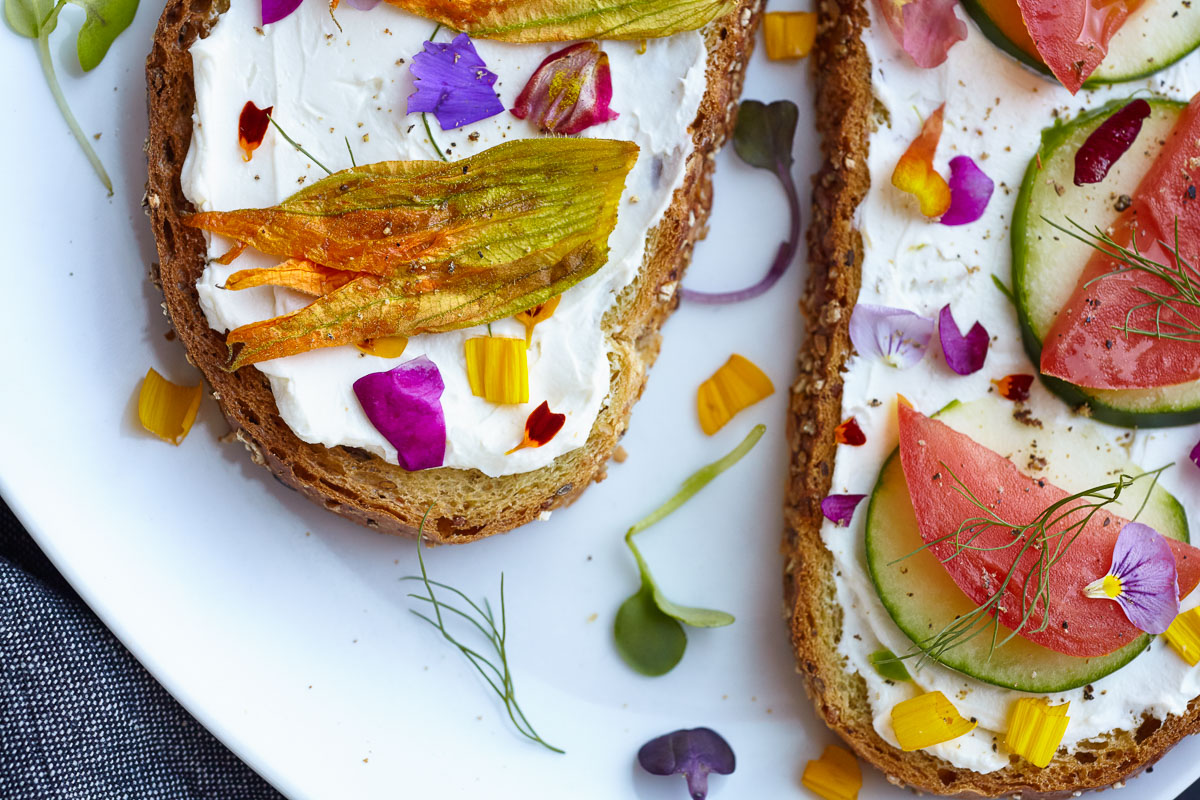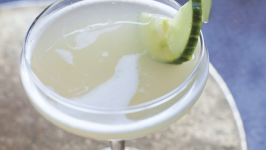How to Cook with (and Otherwise Use) Edible Flowers
There’s never been a better time to bring some flowers into your kitchen. As restaurants and bars lean ever more heavily into seasonal and local ingredients, so have edible flora brought color and whimsy to dishes and cocktails.
An Instagram-worthy trend it may be today, but humans have been eating and cooking with flowers since, well, forever—just look at Italy’s fried courgette flowers or Vietnam’s lotus flower dishes. In New York specifically, well-known indigenous edible flowers include bush honeysuckle, wild bergamot, milkweed, wood sorrel and white clover. While there’s no shortage of information online about how to use these plants, it can still be overwhelming for first-timers looking to experiment with flowers.
While working at The Bonnie in Astoria, Mike Di Tota, known as “The Botanical Bartender,” tapped into his extensive background in botany—the man holds a degree in horticulture and can identify hundreds of varieties of plants—to create crowd-pleasing drinks that leverage seasonal produce and ingredients in cordials, tinctures and more.
“Flowers are eye-catchers on a menu—if you’ve got lavender, chamomile or hibiscus on a menu, the drink becomes very appealing,” says Di Tota. “Whether it’s spices and barks for winter or flowers for spring, people love tasting what they’re seeing and feeling around them.”
For most applications, Di Tota recommends purchasing dry flowers both because “the flavors are more concentrated and intense” and because dry ingredients have a longer shelf life. But that doesn’t mean fresh flowers don’t work.
Queens residents can find a host of different flowers growing right in their borough—popular foraging areas include Forest Park, Cunningham Park and Alley Pond Park. Di Tota says he’s used honeysuckle growing right in his own backyard for a flavored simple syrup.
“Wildman” Steve Brill, a local botanist who hosts regular foraging tours, recommends the likes of redbud, wisteria, black locust, daylilies in the spring and, for the summer, Asiatic dayflower and quickweed. “They’re found in grassy, sunny areas, on lawns and at the edge of trails throughout Queens,” he says. “All the parks in Queens have edible flowers. That’s why mowers are continually cutting down wild plants.”
If, on the other hand, you do not feel comfortable foraging for your own flowers, growing them at home is an option, as is visiting a local farmers market. “Using flowers or beautiful herbs that you’ve grown yourself and have familiarity with is best, but there are many selections at our farmers markets as well with the added benefit of being able to ask for this information,” says Sarah Owens, James Beard Award–winning cookbook author and founder of Ritual Fine Foods. “The added bonus is you are using botanicals that are in season rather than supporting toxic flower farms in distant locations with a large carbon footprint.”
Ready to get started? Whether you’re foraging, ordering dried flowers or stopping by a local vendor, here are several ways to make the most of flowers in your home bar or kitchen.
Amp up your garden-variety sweetener
Whether you’re planning to shake a cocktail or bake a cake, a basic simple syrup is the best place to dip your toes in floral waters. It’s as easy as boiling one part water, adding one part sugar, removing the syrup from heat and, finally, adding a handful of dried flowers while the mixture is cooling. Di Tota’s done it with all kinds of flowers ranging from honeysuckle to nasturtium and even hops.
The method also works for honey and ginger syrups. Di Tota says one of his favorite drinks, hands down, is gin and lemon juice mixed with a lavender-infused honey syrup. In fact, when testing out applications for your flower syrups, it’s best to start with more elemental combinations of spirit, citrus and sweetener in order to see how those floral flavors shine through.
Infuse them right into your spirits—or make tinctures and cordials
Alternatively, you can infuse the flowers directly into the booze. That could be as simple as steeping them directly in the bottle—the alcohol will extract the flavors naturally. Di Tota says vodka works best here, as it’s a neutral canvas that can be adapted to new flavor profiles. However, one of his favorite combinations is a botanical bomb of chamomile and gin.
Simply add heat—cook them in a stir-fry or soup
In the kitchen, Brill recommends Asiatic flowers in a dayflower fried rice, as they “lend just the right touch, along with Chinese five-spice seasoning, to turn leftover rice into a fantastic dish.” His simple recipe calls for leftover rice fired up with red onions, garlic, five-spice, soy sauce and a couple cups of Asiatic dayflower.
Soup is also on the menu for Brill, who employs quickweed in a rich vegetarian recipe for cream of quickweed soup: “Quickweed imparts a wonderful artichoke-like flavor to the recipe, while the other herbs and spices make it even better!” Here, home cooks can treat quickweed like a leafy green, heating it up in oat milk with arrowroot, white miso, paprika, nutmeg and cayenne pepper, then blending and straining the purée.
Use them as a garnish—on drinks, in salads or on cakes
Serving a cocktail with crushed ice? Why not drop a few fresh flowers or petals on top? If you’re working with a salad or some other non-heated preparation, consider carnations, nasturtiums or even pansies—be sure to remove stems and bases as they tend to be quite bitter and unpleasant on most flowers.
Owens, who has worked with flowers on cakes and other baked goods, suggests considering the time between when the cake is decorated and when it will be served. “Succulents are a great choice for best performance if the cake is sitting out for a lengthy period of time before being served, as they are mostly nontoxic and do not need water to keep them looking fresh,” she advises.
“If you are picking the flowers yourself, prepare a lidded container with a dampened paper towel, pick the botanicals in the early morning or late evening when the stress of the sun has subsided, place the flowers or herbs in the container and secure the lid and keep in the refrigerator until ready to decorate and serve the cake.”
Give your cheese a colorful wrap
“There’s a whole tradition in cheesemaking of using edible flowers both fresh and dry, whether that is simply crusting the rind of the cheese for decoration or actually aging cheese with flowers and herbs so the cheeses pick up those flavors,” explains Queens cheese expert and cookbook author Tia Keenan.
Next time you’re serving cheese and charcuterie, consider a crafty and colorful presentation for those curds. Start by chopping up your flower of choice—bright colors like those of calendulas and borages will offer sharp visual contrast to the white hues of cheese. Keenan suggests using a softer cheese that will stick to and hold your petals.
“The trick is that you want to work with a really cold piece of soft cheese so that it won’t become misshapen when you’re handling it,” says Keenan. “In this case, use fresh flowers and even some herbs, and just press them onto your cheese log.”
Pair them with other ingredients from the same place
And finally: This isn’t so much a specific technique but a good and simple rule of thumb when you’re experimenting on your own. “What grows together, goes together,” says Di Tota. “Hibiscus and agave come from the same regions in Mexico—so try hibiscus with tequila or mezcal.”


















